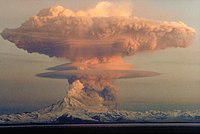
Photo from wikipedia
A k‐means cluster analysis of a 5‐year aerosol particle size distribution data set from northeast Greenland is combined with measurements of coincident shorter field studies of aerosol equivalent black carbon… Click to show full abstract
A k‐means cluster analysis of a 5‐year aerosol particle size distribution data set from northeast Greenland is combined with measurements of coincident shorter field studies of aerosol equivalent black carbon (eBC) content, hygroscopic growth factor (HGF), and cloud condensation nuclei (CCN) concentrations. This led to five clusters strongly controlled by natural emissions (eBC 8–15 ng/m3) and three anthropogenic clusters with larger particle concentrations in the accumulation mode (eBC 29–77 ng/m3). The HGF and CCN properties of the eight aerosol clusters differ drastically. Anthropogenic clusters feature high growth factors (1.62–1.81) and low CCN κ values (0.10–0.46), while natural clusters show lower HGF (1.38–1.70) but remarkably higher κ values (0.35–0.51). Extrapolating the CCN properties on the basis of the cluster analysis to annual timescales suggests that biogenic organic aerosol may drive Arctic aerosol production during summer.
Journal Title: Geophysical Research Letters
Year Published: 2019
Link to full text (if available)
Share on Social Media: Sign Up to like & get
recommendations!